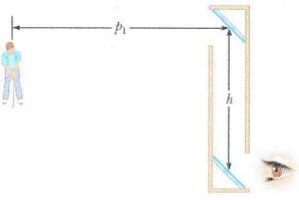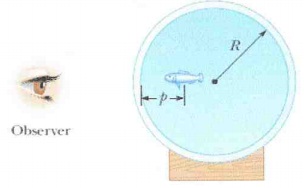Assignment:
Problems:
1. A periscope (see figure below) is useful for viewing objects that cannot be seen directly. It can be used in submarines and when watching golf matches or parades from behind a crowd of people. Suppose the object is a distance pi from the upper mirror and the centers of the two fiat mirrors are separated by a distance h.

(a) What is the distance of the final image from the lower mirror? (Use any variable or symbol stated above as necessary.)
(b) Is the final image real or virtual?
(c) Is it upright or inverted?
(d) What is its magnification?
(e) Does it appear to be left-right reversed?
2. A dentist uses a mirror to examine a tooth that is 1.00 cm in front of the mirror. The image of the tooth is formed 5 cm behind the mirror.
(a) Determine the mirror's radius of curvature.
(b) Determine the magnification of the image.
3. To fit a contact lens to a patient's eye, a keratometer can be used to measure the curvature of the cornea-the front surface of the eye. This instrument places an illuminated object of known size at a known distance p from the cornea, which then reflects some light from the object, forming an image of it_ The magnification M of the image is measured by using a small viewing telescope that allows a comparison of the image formed by the cornea with a second calibrated image projected into the field of view by a prism arrangement. Determine the radius of curvature of the cornea when p = 28.0 cm and M = 0.0120.
4. A virtual image is formed 19.5 cm from a concave mirror having a radius of curvature of 45.0 cm.
(a) Find the position of the object.
(b) What is the magnification of the mirror?
5. While looking at her image in a cosmetic mirror, Dina notes that her face is highly magnified when she is close to the mirror, but as she backs away from the mirror, her image first becomes blurry, then disappears when she is about 32.0 cm from the mirror, and then inverts when she is beyond 32.0 cm. Based on these observations, answer the following questions about the mirror.
(a) What type of mirror does Dina have?
(b) What is the focal length of the mirror?
(c) What is the radius of curvature of the mirror?
6. A cubical block of ice 33.0 cm on an edge is placed on a level floor over a speck of dust. Locate the image of the speck, when viewed from directly above, if the index of refraction of ice is 1.309.
7. A goldfish is swimming inside a spherical bowl of water having an index of refraction n = 1.333. Suppose the goldfish is p = 10.1 cm from the wall of a bawl of radius 'RI = [6.4 cm, as in the figure below. Neglecting the refraction of light caused by the wall of the bowl, determine the apparent distance of the goldfish from the wall according to an observer outside the bowl.

8. A contact lens is made of plastic with an index of refraction of 1.45. The lens has an outer radius of curvature of ±1.92 cm and an- inner radius of curvature of 4-2.44 cm. What is the focal length of the lens?
9. A converging lens has a focal length of 48.0 cm. Locate the images for the following object distances, if they exist. Find the magnification.
(a) 48.0 cm
(b) 6.86 cm
(c) 336 cm
10. A diverging lens has a focal length of magnitude 23.2 cm.
(a) Locate the images for each of the following object distances.
(b) Is the image for the object at distance 46.4 real or virtual?
. Is the image for the object at distance 23.2 real or virtual?
. Is the image for the object at distance 11.6 real or virtual?
(c) Is the image for the object at distance 46.4 upright or inverted?
. Is the image for the object at distance 23.2 upright or inverted?
. Is the image for the object at distance 11.6 upright or inverted?
(d) Find the magnification for the object at distance 46.4 cm.
. Find the magnification for the object at distance 23.2 cm.